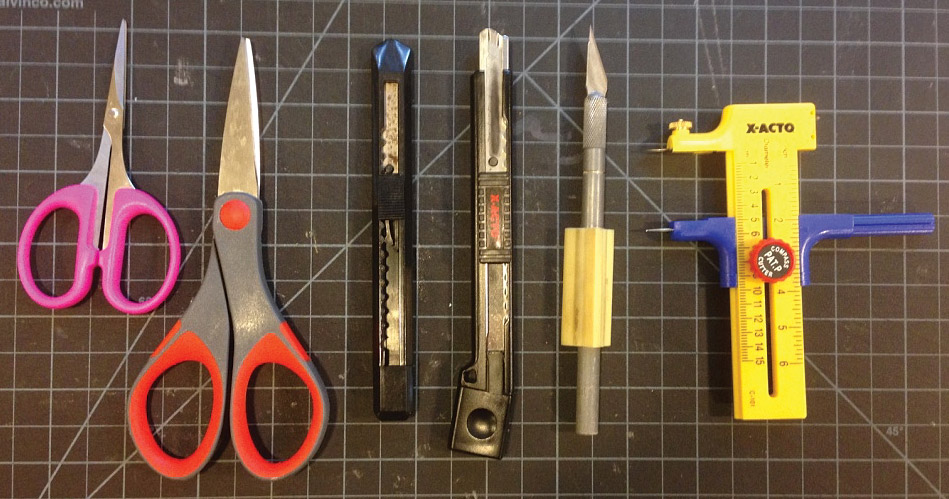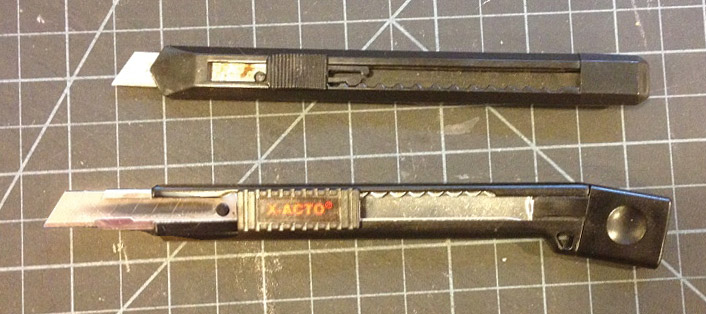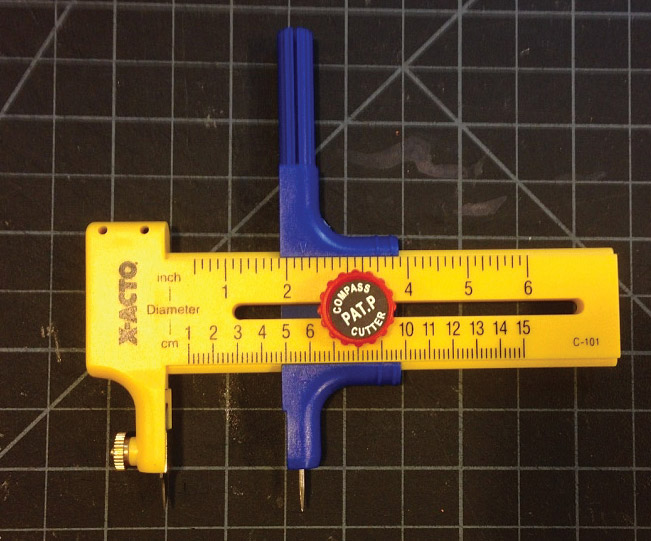Making papercraft is pretty basic, it involves a design printed onto sheets of paper which are then cut out, folded and glued. I’m going over the tools I use to cut out the parts and their various advantages or short comings. My four main tools for cutting are: a pair of scissors, a utility knife with a snap-off blade, a x-acto knife and a compass cutter.

Scissors
This is the basic cutting tool everyone should know how to use. Scissors are versatile and easy to use and already found in most households. I use a pair of small craft scissors that I purchased from my local art store for around $2 (smaller pair). They have a short pointy blade. I also use a slightly larger pair if I have large pieces to cut.

Pros: Scissors are a common tool that are easy to find and easy to use. They are great if you are making papercraft with children because they are relatively safe to use. They are the best tool for cutting large curves and the quickest way to roughly remove parts from a sheet for finer cutting.
Cons: Scissors are terrible when dealing with concave curves, inset parts or slots (especially inset right angles) or super fine details like irregular edges or rows of triangular tabs.
Utility knife with a snap-off blade
This is my work horse of cutting tools. One of the most important things to consider when cutting is that your blade is always sharp. When I feel the blade is not cutting well or is leaving little snags, I can simply remove the blade’s end cap and snap off the end of the blade exposing a nice fresh sharp blade.

Pros: Simple to use and it feels good in the hand. You can always and easily get a sharp blade. These blades are also super versatile for any cutting that you may need to do. They are difficult to cut yourself with (not impossible though – so be careful) and because the blade retracts they are safe and easy to store.
Cons: The blade is just over a 1/4 inch high, but even at this height it can still sometimes block visibility of what you are cutting especially in detailed areas or areas with a lot of cutbacks.
X-acto knife
A X-acto knife is another type of utility knife that you can switch out the blade on. X-acto is the brand name of the most common of this kind of blade. The blades can be switched out to a variety of different shaped blades that all have special purposes. The most common blade is the #11, a long triangular blade that ends in a sharp point.

Pros: I find that x-actos are the best way to cut paper, especially fine or complicated details. Once you are comfortable using it, it is also faster than using scissors. Also just like the previous utility knife, in conjunction with a ruler it is the fastest and most accurate way to cut straight lines. Although with any of these tools you’ll get the knack of cutting pretty decent straight lines without a ruler.
Cons: These things are dangerous. Realize this and always treat them with caution and respect, they are NOT for children to use. I had a graphic design teacher in college that told us that when using x-actos its not if you will cut yourself but when. In addition, with the #11 blades the very, very tip of the blade has a tendency to break off leaving a tiny shard of sharp metal somewhere on your workspace.
Safety tip: When changing and disposing of any blade, wrap it in a piece of tape so some on picking it up or pushing down trash in the can does not cut themselves.
Compass cutter
This last tool is a specialty tool to cut circles, arches and holes. You can do these tasks with the other tools but a circle cutter does it easier and cleaner.

Pros: The best and cleanest way to cut circles and holes.
Cons: There are limitations to the size holes you can cut. This tools has limited uses.
Tip: Always rotate the compass cutter and not the paper you are trying to cut. there is a pin you push in at the center point of the circle that you are cutting and if you rotate the paper there is a good chance the you will tear the paper where the pin is stuck in and change the dimensions of the circle. I usually leave a little extra material on the part I’m about to cut and then I tape the part to my cutting board.